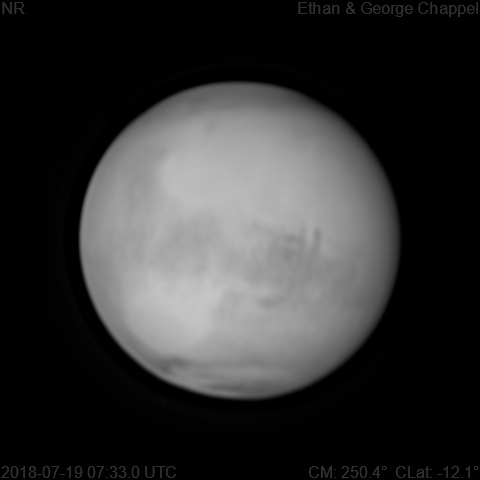
Mars UTC
CM1: 250.40°
CLat: -12.10°
Description
I decided to capture data in infrared before closing down for the night. Seeing continued to be good.
Notes:
- Syrtis Major and Hellas Basin are rising.
- Mare Cimmerium is the dark feature most prominently visible through the dust storm.
- The South Polar Cap appears muted by the dust storm.
- Most of the SPC also appears to be darkened.
Equipment
Astro-Physics Advanced Convertible Barlow
Celestron EdgeHD 14
ZWO ASI290MM
Logs
FireCapture v2.6 Settings ------------------------------------ Observer=Ethan Chappel Location=Cibolo, TX, USA Scope=Celstron C14 EdgeHD Camera=ZWO ASI290MM Filter=IR Profile=Mars Diameter=23.68" Magnitude=-2.66 CM=249.4° (during mid of capture) FocalLength=8550mm (F/24) Resolution=0.07" Filename=2018-07-19-0727_7-EC-IR-Mars.ser Date=190718 Start=072632.307 Mid=072747.311 End=072902.316 Start(UT)=072632.307 Mid(UT)=072747.311 End(UT)=072902.316 Duration=150.009s Date_format=ddMMyy Time_format=HHmmss LT=UT -6h Frames captured=14991 File type=SER Binning=no Bit depth=8bit Debayer=no ROI=428x414 ROI(Offset)=0x0 FPS (avg.)=99 Shutter=10.00ms Gain=188 (31%) Gamma=50 Brightness=1 (off) AutoHisto=75 (off) SoftwareGain=10 (off) USBTraffic=40 (off) AutoGain=off HighSpeed=off AutoExposure=off FPS=100 (off) Histogramm(min)=0 Histogramm(max)=127 Histogramm=49% Noise(avg.deviation)=0.50 Limit=150 Seconds Sensor temperature=34.3°C Focuser position=1618 FireCapture v2.6 Settings ------------------------------------ Observer=Ethan Chappel Location=Cibolo, TX, USA Scope=Celstron C14 EdgeHD Camera=ZWO ASI290MM Filter=IR Profile=Mars Diameter=23.68" Magnitude=-2.66 CM=250.2° (during mid of capture) FocalLength=8500mm (F/23) Resolution=0.07" Filename=2018-07-19-0731_1-EC-IR-Mars.ser Date=190718 Start=072951.098 Mid=073106.101 End=073221.105 Start(UT)=072951.098 Mid(UT)=073106.101 End(UT)=073221.105 Duration=150.007s Date_format=ddMMyy Time_format=HHmmss LT=UT -6h Frames captured=14990 File type=SER Binning=no Bit depth=8bit Debayer=no ROI=428x414 ROI(Offset)=0x0 FPS (avg.)=99 Shutter=10.00ms Gain=188 (31%) Gamma=50 Brightness=1 (off) AutoHisto=75 (off) SoftwareGain=10 (off) USBTraffic=40 (off) AutoGain=off HighSpeed=off AutoExposure=off FPS=100 (off) Histogramm(min)=0 Histogramm(max)=125 Histogramm=49% Noise(avg.deviation)=0.49 Limit=150 Seconds Sensor temperature=34.7°C Focuser position=1628 FireCapture v2.6 Settings ------------------------------------ Observer=Ethan Chappel Location=Cibolo, TX, USA Scope=Celstron C14 EdgeHD Camera=ZWO ASI290MM Filter=IR Profile=Mars Diameter=23.68" Magnitude=-2.67 CM=251.1° (during mid of capture) FocalLength=8450mm (F/23) Resolution=0.07" Filename=2018-07-19-0734_7-EC-IR-Mars.ser Date=190718 Start=073327.512 Mid=073442.517 End=073557.523 Start(UT)=073327.512 Mid(UT)=073442.517 End(UT)=073557.523 Duration=150.011s Date_format=ddMMyy Time_format=HHmmss LT=UT -6h Frames captured=14990 File type=SER Binning=no Bit depth=8bit Debayer=no ROI=428x414 ROI(Offset)=0x0 FPS (avg.)=99 Shutter=10.00ms Gain=188 (31%) Gamma=50 Brightness=1 (off) AutoHisto=75 (off) SoftwareGain=10 (off) USBTraffic=40 (off) AutoGain=off HighSpeed=off AutoExposure=off FPS=100 (off) Histogramm(min)=0 Histogramm(max)=121 Histogramm=47% Noise(avg.deviation)=0.49 Limit=150 Seconds Sensor temperature=34.7°C Focuser position=1508 FireCapture v2.6 Settings ------------------------------------ Observer=Ethan Chappel Location=Cibolo, TX, USA Scope=Celstron C14 EdgeHD Camera=ZWO ASI290MM Filter=IR Profile=Mars Diameter=23.68" Magnitude=-2.67 CM=252.0° (during mid of capture) FocalLength=8450mm (F/23) Resolution=0.07" Filename=2018-07-19-0738_5-EC-IR-Mars.ser Date=190718 Start=073715.607 Mid=073830.611 End=073945.615 Start(UT)=073715.607 Mid(UT)=073830.611 End(UT)=073945.615 Duration=150.008s Date_format=ddMMyy Time_format=HHmmss LT=UT -6h Frames captured=14991 File type=SER Binning=no Bit depth=8bit Debayer=no ROI=428x414 ROI(Offset)=0x0 FPS (avg.)=99 Shutter=10.00ms Gain=188 (31%) Gamma=50 Brightness=1 (off) AutoHisto=75 (off) SoftwareGain=10 (off) USBTraffic=40 (off) AutoGain=off HighSpeed=off AutoExposure=off FPS=100 (off) Histogramm(min)=0 Histogramm(max)=118 Histogramm=46% Noise(avg.deviation)=0.48 Limit=150 Seconds Sensor temperature=34.6°C Focuser position=1468